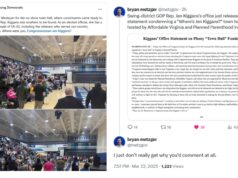Arlington County Treasurer Frank O'Leary has been predicting election turnout for many moons. Unfortunately, in recent years, the model that worked for him all that time started breaking down, as the relationship between the number of absentee ballots cast and the final vote tally became more and more tenuous. Despite that, O'Leary has taken a stab at predicting Arlington voter turnout for this coming Tuesday, and I thought it was worth passing along.
Predicted Turnout for November 2013
A Short History
Virginia’s four year electoral cycle, and that of Arlington, is clearly demonstrated by the following table, reflecting over forty years of electoral activity in general elections.
|
Average Registration and Turnout by Type of Race, 1972-2012 |
||||
|
Top of Ticket |
Active Registration |
Turnout |
%Turnout |
|
|
President |
102,484 |
83,624 |
81.6% |
|
|
Congress |
96,847 |
54,190 |
56.0% |
|
|
Governor |
96,594 |
49,216 |
51.0% |
|
|
Constitutionals |
96,609 |
34,898 |
36.1% |
|
The Presidential year is clearly dominant in every respect. The fact that Congressional races exceed Gubernatorial in turnout is largely due to the periodic phenomenon of a contested race for the US Senate topping the ticket. This is most clearly demonstrated by the very hot Senatorial races of 1994 and 2006.
|
Top of Ticket |
Active Registration |
Turnout |
%Turnout |
|
1994 – Robb/North |
95,621 |
66,861 |
69.9% |
|
2006 – Webb/Allen |
113,950 |
73,499 |
64.5% |
|
US Representative |
102,884 |
51,945 |
50.5% |
As can be seen, the 1994 Senate race had the highest percent turnout of any non-presidential year, while the 2006 race enjoyed the highest level of absolute turnout (given the increase in voter registration). In 2006, absentee voting also peaked for a non-presidential year when 7,077 or 9.6% voted absentee, This was part of a trend which commenced in 2005 as voters became increasingly aware of the absentee option 9a knowledge abetted by candidates and party) for voting absentee and has persisted ever since.
Examining the three most recent Gubernatorial Years, we find as follows.
Recent Gubernatorial Turnout
|
Year |
Active Registration |
Turnout |
Absentee |
%Active Turnout |
%Absentee |
|
2001 |
108,910 |
53,302 |
2,135 |
48.9% |
4.0% |
|
2005 |
113,274 |
57,217 |
3,294 |
50.5% |
5.8% |
|
2009 |
131,541 |
56,415 |
4,600 |
42.9% |
8.2% |
Quite obviously, the race in 2009 failed to ignite the Arlington electorate to the same degree as the prior two years. Given the rise in registration, I had predicted that turnout might hit 65,000 – it did not. Had it done so, the %Absentee would have been 7.1%, instead of 8.2%, continuing the trend upward in a very predictable manner.
Current Events
This year’s race will probably set the record for turnout in a Gubernatorial Year. In 2009, with seven days of voting remaining, 2,914 absentee votes had been cast. This year, 4,476 have already voted absentee and I expect the final number to hit 7,200 or more.
It seems likely that this remarkable increase in absentee turnout is a direct result of federal workers being furloughed. During the furlough period, 500 additional votes occurred when compared to 2009. Those additional votes may well have arisen from angry federal workers, who had nothing better to do, and they (and other incensed parties) may well have continued voting after the furlough ended. In the absence of the furlough, absentee turnout to date might have equaled only 3,500 or so, putting it on pace with the longer range trend. The question that now arises is whether these same voters planned on turning out on November 5. In short, are they merely voting “early” rather than “often”? The answer to this question affects total turnout.
The “Prediculator” of bygone days remains in the lower level garage next to Tony Kornheiser’s “Bandwagon”. In its absence I will opine as follows, with an update to follow on Monday.
|
Year |
Active Registration |
Turnout |
Absentee |
%Active Turnout |
%Absentee |
|
2013 |
137,027 |
70,000 |
7,200 |
51.1% |
10.3% |



 Sign up for the Blue Virginia weekly newsletter
Sign up for the Blue Virginia weekly newsletter
![“Skilled” at Breaking the Law: “This latest attempt to sidestep any regulations or oversight shows [that ‘skill’ game developers] have no interest in acting responsibly or in good faith.”](https://bluevirginia.us/wp-content/uploads/2024/10/krizekskilled-238x178.jpg)
![Kamala Harris for Virginia 2024 Director Jake Rubenstein: “This [Donald Trump] is the man @GlennYoungkin sold his soul to”](https://bluevirginia.us/wp-content/uploads/2024/08/jakesoldsoul-238x178.jpg)






